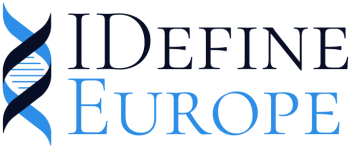Kleefstra Syndrome
is a rare genetic condition.
is caused by the loss of function in the EHMT1 gene (chromosome 9).
affects development and involves many body systems.
What are the symptoms and causes?
Individuals with Kleefstra Syndrome (KLFS) usually have distinct facial features, developmental delay, intellectual disability, low muscle tone (hypotonia) and communication difficulties. KLFS causes a range of symptoms that can differ from person to person. Other names for KLFS from the past: 9q-syndrome, 9q34.3 deletion syndrome, and chromosome 9q deletion syndrome.
KLFS is caused by the loss of function of one copy of the EHMT1 gene. In about 50 % of cases, a variation or “mutation” in one copy of the EHMT1 causes the loss of function. The remaining cases are caused by the deletion of one copy of a segment of chromosome 9, which includes the gene EHMT1. The role of EHMT1 is to produce an enzyme (histone methyltransferase 1), that controls the activity of other genes in the body. When one copy of EHMT1 loses its function, it affects a large number of other genes involved in development and functioning of organs and tissues throughout the body. Almost all cases reported have been de novo (not inherited).
Sources:
https://medlineplus.gov/genetics/condition/kleefstra-syndrome/
https://www.childrenshospital.org/conditions/kleefstra-syndrome
We operate globally
IDefine Europe is connected to the US-based non-profit organization IDefine. The two organizations operate globally, but because they are based in the U.S. and Europe, they also have legal legitimacy for their activities. Our two continents have different healthcare systems and are different in many ways. With both organizations (IDefine Europe and IDefine), we will better understand healthcare systems, the rare disease landscape, and patients. We are working hand in hand for a better future for our children with Kleefstra syndrome. One of many symptoms is intellectual disability (short for ID), from which our name derives: IDefine.
We share a common goal with OTHER PATIENT ORGANIZATIONS
The Kleefstra Syndrome Europe Alliance is a central coordination hub for Kleefstra syndrome in Europe. The hub brings together national Kleefstra patient organisations and groups from Europe. We work together to improve the lives of our children with Kleefstra syndrome (type 1, gene EHMT1) by providing contacts and information.
National Kleefstra syndrome patient organizations and contact points in Europe (click on the map)
Kleefstra syndrome Italy
Kleefstra syndrome Spain
Kleefstra syndrome UK
Kleefstra syndrome Slovenia with Croatia and Serbia (IDefine Europe)
Kleefstra syndrome Netherlands (ZeldSamen)
Kleefstra syndrome German speaking community
Kleefstra syndrome community in Hungary
Kleefstra syndrome community in Turkey
Kleefstra syndrome community in Poland
Kleefstra syndrome point in Romania
Kleefstra syndrome point in Czech Republic
Kleefstra syndrome point in Greece
Kleefstra syndrome point in Norway (Frambu)
Outside Europe
Kleefstra syndrome Japan
Kleefstra syndrome community in South America
Kleefstra syndrom Brazil
Kleefstra syndrome community in Canada
Kleefstra syndrome community in Australia
Kleefstra syndrome community in New Zealand
For more information you may contact IDefine Europe for Europe related inquiries at info@idefine-europe.org and IDefine for America/Canada/Australia related questions.
We are part of the international Kleefstra syndrome movement.
The international Kleefstra syndrome movement advocates for Kleefstra syndrome to be recognised as a rare disease and to be researched as much as possible. We strive to include all Kleefstra syndrome cases worldwide. That is the mission of the Kleefstra Syndrome worldwide map. It displays the locations of KS individuals around the globe.
By adding your child or relative with Kleefstra syndrome to the map, you will help determine the prevalence of Kleefstra syndrome. To do so go to https://www.kleefstraworldmap.org/.
Active data collection projects/surveys for Kleefstra syndrome:
Share valuable information about your child to support the collection of patient data and help accelerate progress. Click on the provided logos below and you will be diverted to the survey site/data collection platform for Kleefstra syndrome.
